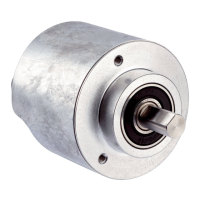Implicit messaging is used in EtherNet/IP for real-time communication between the
controller and the encoder. Implicit messaging establishes a connection between
exactly two devices within the CIP, e.g. to transmit I/O data such as position, speed,
etc. from the encoder to the controller (see "Position sensor object", page 27). Implicit
messaging uses UDP/IP over port 2222. It thus uses fast data throughput.
Explicit messaging is used in EtherNet/IP for communication that does not need to
take place in real time. Explicit messaging uses TCP/IP, it is used, e.g., to transmit
parameters from the controller to the encoder (see "Assembly object", page 22).
Common industrial protocol (CIP)
EtherNet/IP uses the CIP at the process level. This protocol is used to control processes
in a similar way to how FTP is used to send files, for example.
FTP HTTPCIP
TCP UDP
IP
Ethernet
Figure 6: CIP and other services
1
Process level
2
Communication levels
3
Physical level
The absolute encoder complies with the guidelines of the EtherNet/IP protocol accord‐
ing to IEC 61784-1 and those of encoder profile 22h.
The encoder is an I/O adapter within the EtherNet/IP. It receives and sends explicit
messages and implicit messages cyclically or on request.
EtherNet/IP communication
EtherNet/IP is based on the standard Ethernet frame. This contains the Ethernet
header, the Ethernet data and the Ethernet trailer. The MAC addresses of the receiver
(destination address) and the source (source address) are contained in the Ethernet
header.
Figure 7: Ethernet frame
1
Transmission order
2
Header
PRODUCT DESCRIPTION 3
8014213/1EF3/2021-12-08 | SICK O P E R A T I N G I N S T R U C T I O N S | AFS/AFM60 EtherNet/IP
17
Subject to change without notice

